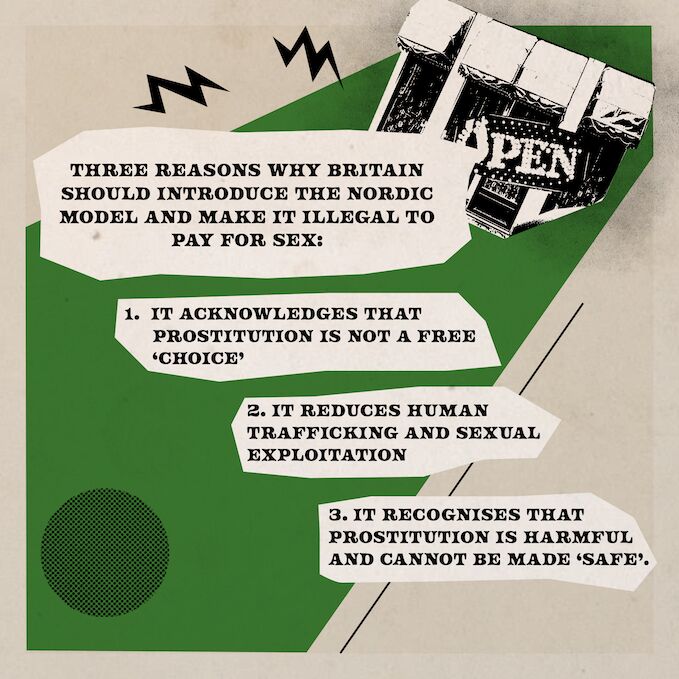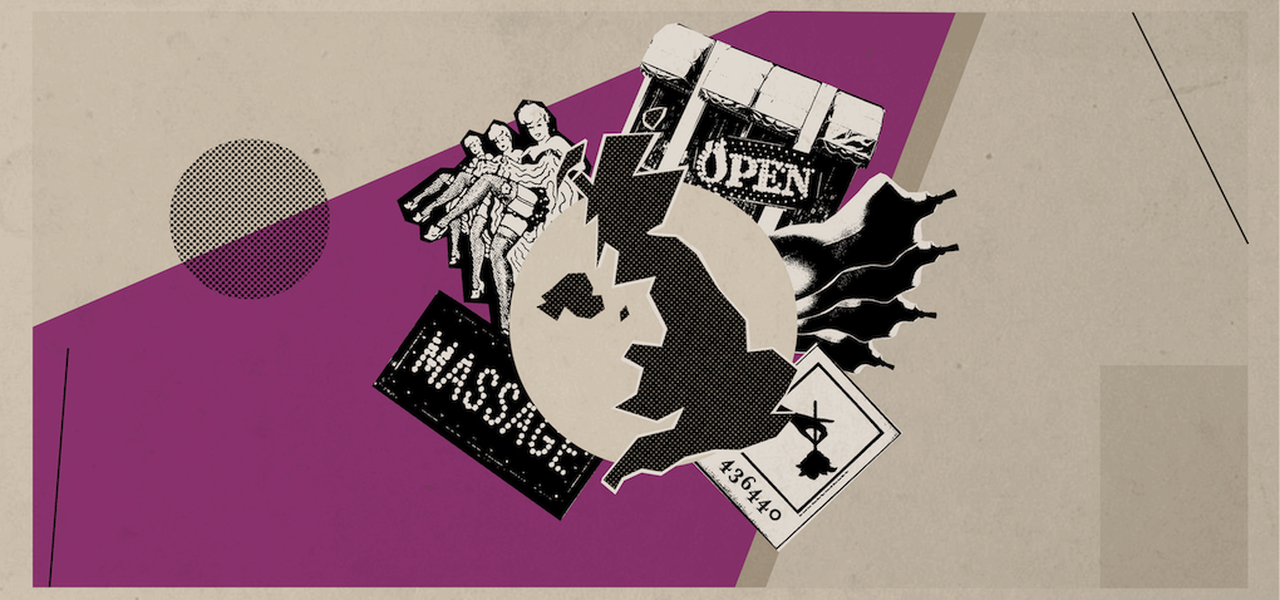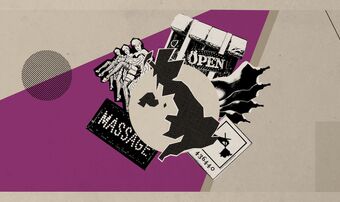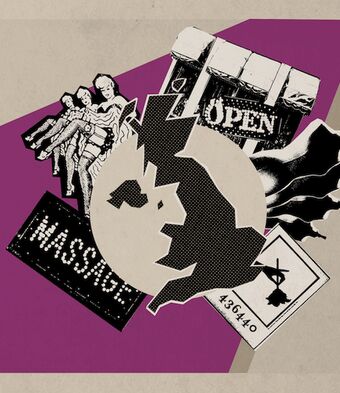As outlined in Part One, there are several different approaches to tackling prostitution. At CARE, we believe that Britain should adopt the so-called Nordic Model, which makes it illegal to pay for sex and helps those in prostitution to exit.
There are three reasons why this is the best policy objective to tackle the issue and why this the approach the Government should adopt to ensure justice for the majority.
1. The Nordic Model acknowledges that prostitution is not a free ‘choice’
The best available evidence absolutely bears out that, you know, by and large, women do not choose to be in prostitution. Those few exceptions should not be forming the policy goals here.
Whilst some say they enter prostitution as a free choice and do not find it to be a negative or detrimental experience, it is more often a lack of choice that forces people to enter prostitution.
Last year, the Conservative Human Rights Commission held an inquiry into prostitution in England and Wales. They found that “the overwhelming majority of those in prostitution would not meet the threshold for establishing free choice – most describe their choice to enter prostitution as dictated by their circumstances.”
Organisations working with people in prostitution acknowledge this. One frontline support worker stated,“... throughout my career I am yet to meet a woman who made a conscious choice to enter prostitution without an external force such as poverty or relationships being at play.”
Whilst the glamorised stories we more commonly hear in the media often paint prostitution as an empowering business decision, this is a false picture of the reality for most women. As Rebecca Perry from Safe Exit describes,
Through my experience, the women we’ve worked with, we’ve never met a woman who has consciously made a decision that that is the career choice that she’s obviously decided for. It’s something that she’s found herself within, and there’s no point within her experience where she can actually pinpoint the moment that she entered, because it’s such a continuum. So I think for that reason, that evidences the fact that it’s not a choice; it’s a coercion. It’s something out of desperation.
Amongst the circumstances that lead women to enter prostitution, one of the most common is childhood abuse. Home Office data has shown that 45% of those in prostitution report an experience of sexual abuse, and one study found that as many as 72% of participants had suffered some form of childhood violence, including emotional, physical, verbal and sexual violence.
There is also evidence that many people enter prostitution at a young age, sometimes under the age of 18, through coercion, drug use, or experiences of childhood violence. This makes it incredibly difficult to exit. According to one study, many interviewees were "unable to remember life before prostitution" and, as such, found it much more difficult to "form a new role and way of life".
The women that we work with report to us experiences, extreme experiences, of child sexual abuse from an incredibly young age, from literally the day they were born. They have extremely problematic lifestyles. Again, it’s a continuum. There’s no point at which they can say, ‘that event occurred and caused this and triggered this behaviour.'
There is also evidence demonstrating that high numbers of women in prostitution have experienced coercion from a partner, relative or pimp — with incidents of violence at a much higher rate than the rest of society. This coercion includes the use of threats or violence, including physical, sexual, emotional and financial abuse in order to maintain control over a woman in prostitution. One study in 2012 found that 50% of women surveyed had experienced coercion, which is cited as another barrier to exit.
Alongside this is prevalence in drug and alcohol abuse. Several studies have found that between 50% and 95% of women in street prostitution are addicted to Class A drugs.
Michelle Kelly, a survivor of the sex industry, summarises her experience of this destructive cycle — one common to many in prostitution:
My reasons for this apparent ‘free choice’ were, however, driven by an abusive relationship and a Class A drug addiction. I was also still suffering the long-term trauma of childhood sexual abuse. That a high percentage of child abuse survivors enter prostitution is no coincidence; we learn the limits of consent from a young age. I wasn't so much paid to have sex so much as to stay silent about being abused, and to lie and pretend this was ‘a job like any other’. Maintaining this dissonance had detrimental effects on my health and wellbeing. Here is another not-coincidence; prostitutes have rates of PTSD similar to that of war veterans.
This is patently exploitation, not empowerment. Describing experiences like these with words like 'choice' is utterly misleading.
As Dr Jacci Stoyle describes, it is deeply problematic when we start to consider something exploitative as ‘just another job' — language matters in this debate:
When a society changes the language it uses to describe things, it changes the way those things are perceived. So, by reframing abuse and exploitation of vulnerable young women into something perfectly normal and innocuous, prostitution has been reconstituted into simply another option in the labour market.
Prostitution is not an ‘employment option’ anyone should be advocating for: it significantly increases harm to already vulnerable individuals, facilitates coercive abuse, and has many associated harms even for those who do not feel it is detrimental to them overall, such as violence from customers.
The evidence is clear: if prostitution is a decision women make in desperate circumstances, and has clearly associated harms, the Government should do all they can to reduce levels overall.
The most effective answer to achieve this aim is the Nordic model. Following the introduction of the Nordic model in Sweden in 1999, reports have shown that there has been a decrease in overall levels of prostitution, a reduction in on-street prostitution and a significant reduction in the numbers of men saying they have paid for sexual services, from 13.6% in 1996 to 7.5% in 2014.
On the other hand, prostitution in Germany exploded post-legalisation, and it has become an attractive destination for so-called ‘sex tourism’, with estimates that the rate of prostitution there is thirty times that of the rate in Sweden. Street prostitution in New Zealand also increased by 400% following the change to the law.
As much as those advocating for legalisation may argue about individual agency, what must be recognised is that with any policy objective designed to reduce the harm caused to the majority, there will necessarily be limitations on individual autonomy if prostitution is to be reduced overall. Legalisation or decriminalisation normalises prostitution when it should be anything but normal. How can a truly compassionate society place a desire for individual freedom over the desperate needs of women in circumstances of abuse, addiction and exploitation?
2. The Nordic model reduces human trafficking and sexual exploitation
The tolerance of the EU and its member states for the system of prostitution allow for men’s use of and control over women’s body and sexuality, and fuels trafficking in women for sexual exploitation....The question is about having the political courage to recognise that prostitution is intrinsically a form of violence, an obstacle to equality between women and men, and a violation of human dignity.
One of the main reasons the law needs to change is because prostitution is inextricably linked with the issue of human trafficking.
Whilst the majority of people in prostitution have not been trafficked, many women and children are trafficked in order to provide sexual services. Across Britain, 63% of all females referred to the national referral mechanism are victims of sexual exploitation.
Evidence obtained by the APPG on Prostitution in 2018 found that there were 212 active police operations in the UK into sexual exploitation cases. They found it is overwhelmingly foreign national women being exploited in brothels in Britain. For example, they report that Leicestershire police visited 156 brothels, encountering 421 women, between 2016-2017. 86% of the women in the brothels were Romanian. Northumbria Police visited 81 brothels between 2016-2018. 75% were from Romania. In Greater Manchester, police identified 324 new brothel addresses since 2015, all of which are in the hotspot areas for modern slavery in Greater Manchester.
Sexual exploitation is rife and something must be done about it. But you can’t deal with sexual exploitation without addressing prostitution.
Decreasing demand for trafficking
There are two approaches needed to prevent human trafficking: increase prosecutions of traffickers in order to deter them from operating, and decrease the demand for human trafficking.
In order to decrease demand, this will necessarily impact upon prostitution. The logic goes that if there are no ‘buyers’ for sexual services, there will be no ‘market’ where it is profitable to traffic individuals for sexual exploitation. Hence why the Nordic model is best fit to tackle this issue, because it is the only model that explicitly tackles demand for paid sex. This is one of the specific purposes of Northern Ireland’s human trafficking legislation.
Those in the pro-decriminalisation lobby argue that the issue of prostitution and human trafficking should be kept separate, but evidence clearly demonstrates that one facilitates the other. Prostitution is “the context in which sex trafficking takes place.”
In fact, legalising prostitution makes trafficking much harder to police. Several studies have found that those countries that have legalised or decriminalised prostitution have higher levels of trafficking than those who have not done so. A 2018 EUROPOL report found that “in countries where prostitution is legal, suspects were able to exploit minors alongside adults in window prostitution, sex studios, night clubs, etc., often with the support of the business managers.”
In New Zealand the decriminalisation of prostitution has led to a barrier in identifying and assisting victims of trafficking because police have less contact with those who work in the sex industry, as it is now seen as a legitimate business. Instead they focus more on issues of immigration than exploitation.
In the Netherlands, one assessment of the challenges of addressing trafficking in the Dutch legalised prostitution sector concluded that “the legalization and regulation of the prostitution sector has not driven out organized crime. On the contrary, fighting sex trafficking using the criminal justice system may even be harder in the legalized prostitution sector.” According to a police study between 50% and 90% of all those involved in prostitution in Amsterdam have been coerced into it, even in legal establishments.
Similarly, in Germany police officers have reported an “explosive increase in human trafficking from Romania and Bulgaria” and described Germany as a “centre for the sexual exploitation of young women from Eastern Europe, as well as a sphere of activity for organised crime groups from around the world.”
We are one of the top destination countries for trafficking within sexual exploitation. Our legislation and political stand point isn't a strong enough deterrent.
Offences that are aimed to narrowly target those who purchase sex from trafficking victims, as opposed to all who purchase sex, are simply ineffective. A recent comparative analysis of six countries across Europe concluded the following: “criminalising the purchase of sex only where there is proof the person is a victim of trafficking or procuring is inoperable from an enforcement point of view and ineffective in relation to the wider goal of acting as a deterrent and reducing demand.”
The only effective means of reducing the demand for victims of trafficking for sexual exploitation is therefore to criminalise the purchase of sexual services, regardless of whether the individual has been exploited or has willingly entered into prostitution.
Comparing Sweden with its neighbours, for example, it is a reasonable expectation that trafficking is less than it would have been had the law not been introduced, given that demand for women in prostitution has reduced. There is also evidence that it is easier for support services to locate vulnerable women. Similarly, introducing the Nordic model in Norway and Canada has meant rates of trafficking are less than one would have expected them to be.
Some also argue that decriminalising prostitution will drive it underground, but this argument has been rejected by Swedish Police who argue that those ‘buying and selling’ need to find each other and so police are able to use the same tools to find them. The reality is prostitution is already secretive and mostly online; it already involves criminal gangs and organised crime which a regulated system cannot prevent. It cannot go any further underground.
3. The Nordic model recognises that prostitution is harmful and cannot be made ‘safe’.
There’s an epidemic of violence against sex workers.
Rather than the ‘happy hooker’ myth that is often promulgated across media platforms, the evidence suggests that prostitution is one of the most dangerous occupations in the world.
For example, research for the Scottish Government in 2016 found that “most respondents who provide services and support to those involved in prostitution emphasised a range of risks and adverse impacts associated with prostitution in the short and longer term in relation to general and mental health, safety and wellbeing and sexual health.”
The level of harm endured in prostitution significantly outweighs what would be experienced in other workplaces. For example, prostitution cannot be said to be ‘just another job’ when it entails physical violence: research has shown that 61% of women surveyed reported experiences of violence from buyers of sexual services. A comparative study of prostitution in nine countries with over 850 subjects found that 71% had been physically assaulted.
One women’s health project has also found that the majority of women involved in prostitution who came to the project recorded symptoms related to sexually transmitted diseases, reproductive tract infections or other health complications. These consequences are, in fact, so serious that mortality rates are estimated to be 12 times higher among women involved in prostitution than the national average. [i]
As well as physical complications, there are also the psychological harms caused to women involved in prostitution, which often has seriously detrimental effects on the mental health of those involved.
Would decriminalisation make it safer?
The innately harmful nature of prostitution is precisely why some advocate for it to be decriminalised, as they argue this improves conditions if safe venues are provided for prostitution. They also argue decriminalising reduces the stigma of prostitution and ensures that more individuals report violence to the police because they no longer face fear of criminality.
However, the evidence here is scant. There is no clear evidence of a reduction in violence and, in fact, violence increases following decriminalisation — largely because there are no criminal ramifications for individuals paying for sex, and violence and unprotected sex are considered to be ‘acceptable’.
In the Netherlands, where prostitution was legalised in 2000 in order to ‘regulate’ criminal activity, there is clear evidence that organised crime and illegal prostitution continues alongside the legal sector, such as sex with underage individuals or performing violent sex acts. Even in legal establishments, between 50% and 90% of people in prostitution in Amsterdam have been coerced.
In Germany, a psychologist describes the situation since the law changed there: “Since the law destroyed any questioning of the harm in men buying women for sex, the acts are becoming increasingly dangerous, violent and degrading. Buyers pick from a long list of sexual acts, most of which could easily be defined as torture…These acts cause extremely deep, enduring and traumatizing harm to the women.”
In New Zealand, which decriminalised prostitution in 2003, the Prime Minister admitted in 2012 that the reform had failed to meet its aims of reducing underage prostitution. There are also reports of continued violent attacks, and evidence shows that many of those working in brothels continue to feel reluctant to report violence to the police.
Closer to home, the Holbeck area in Leeds is a ‘managed’ area for prostitution where loitering, kerb crawling and soliciting are effectively legalised during set hours. Despite there being reports of an increase in women reporting concerns about dangerous clients and engagement in outreach services, there have also been reports of increased rape, sexual assault and, very sadly, one woman was murdered in 2015.
The Nordic model, decriminalising the provider of sexual services, means that those in prostitution should be able to approach police and report incidents of abuse because they are no longer subject to criminal sanctions. The evidence is disputed, but there are studies that report there is improved access to support under the Nordic model, and confidence that the police will help where brothel keeping, pimping and paying for sex are illegal.
It surely makes sense, therefore, that in order to reduce the harms associated with prostitution it is essential to implement policies that both prevent prostitution in the first place and reduce demand for an industry that facilitates such violence.
Not for sale
The reality is that no model is perfect, but only the Nordic model serves to protect a majority of vulnerable people whose experience of prostitution is profoundly harmful and exploitative.
It’s time that our laws on prostitution were overhauled. They are ineffective, they ignore the significant harm caused to women in prostitution, and they are fuelling an industry that makes Britain attractive to traffickers, leading to the widespread sexual exploitation of women across the UK by organised crime groups.
In Britain, men can easily access women for the purposes of sexual services. This needs to end. It’s time we made it illegal to pay for sex and stand up for those who suffer most in a culture that permits a trade in human dignity.

- [i] Republic of Ireland Parliament (Dáil) Official report of Committee for Justice, Defence and Equality 12th December 2012



